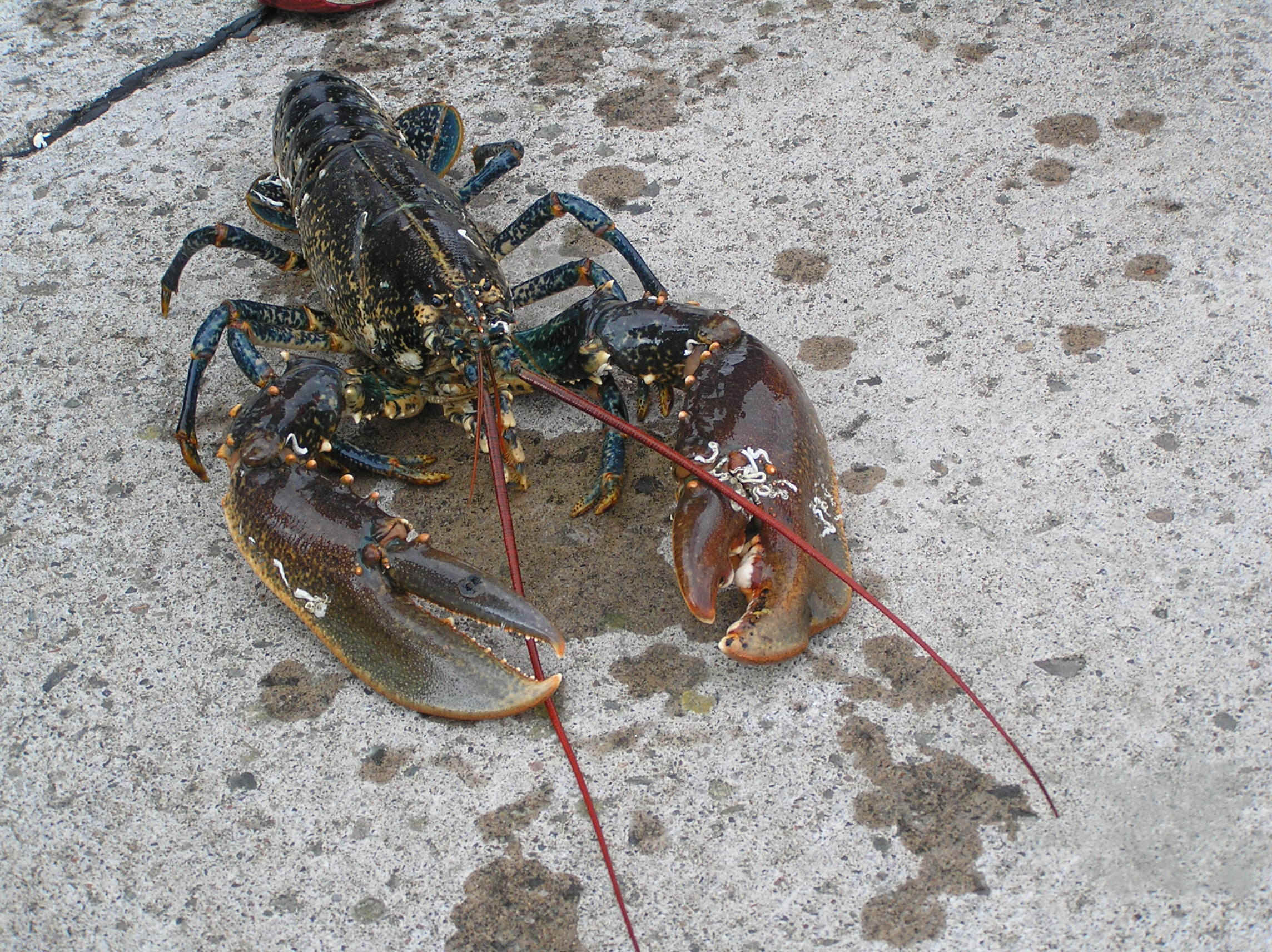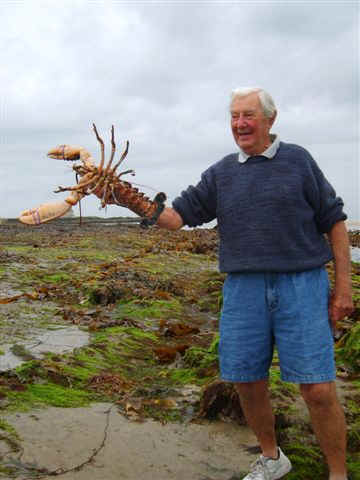Earlsferry Lobsters

Great great great grandma.
A well kept secret that's religiously guarded by the locals of the
fraternity is the existence of lobsters that
during the summer months live under the rocks and ledges of the
seaweed and tangle covered rocks that are exposed for a short
time at the low of the tidal ebb. The
reason that lobsters come into our low tidal rocky places in
the summertime is because this is where they've chosen to live
amidst the habitat of tangles and seaweeds while the females are in the process of spawning. Females have a wider
body aft of their mid section than the males and carry their
eggs on the underside between the mid section and the tail. I
always only took the big males and left the females to live on
to do their thing of starting the new generation. The instant
way to determine the gender of a lobster is that the male has
his larger crusher claw on his right side and his finer serrated
scissor claw is on his left. Female are exactly opposite.
Where
lobsters go in the winter time I don't know but I understand
they travel long distances.
"Time
and tide waits for no man," was never truer than in terms of
lobstering. Each lunar month there are about three days of very
low ebb tides that happen around the full of the moon. These
are lobster tides; time to abandon all other pursuits and head
for the beach. You have at most about an hour and a half to
check out the rocks and ledges known to you as places where
lobsters choose to live and hide out. Start about an hour
before the low of the ebb. When fully out, the tide will then
stop, do nothing for a few minutes, turn, then start pouring
in. You have about half an hour to work when the tide is on the
inflow and covers over the rocks and chases you out. Hopefully
by then you'll have several fine lobsters in your bag and with a
big smile on your face you're heading homewards. Another
great day.
The only
equipment needed is a cleek, a bag and a few rubber bands to
restrain the claws. I made my
cleek from a long golf club driver shaft; an old driver that's
minus its head. In place of the head, insert and attach a piece
of steel rod about 3/16th of an inch diameter, about a foot long
and with a small, pre-bent curve on the outer end.
(Actually I do believe that a straight bamboo cane would move
lobsters out from under the rock ledges
just as well.)
To use:
As sea weeds, tangles and kelp are an essential part of lobster
habitat, first very carefully to not disturb the habitat, lift
and push aside the seaweeds and
the tangles that are now alive and growing and draped
over the rock that you want to expose its underlying ledge.
Ideally, you're working in water that's about a foot
deep. With
the cleek, start in at one side of the ledge and push/feel
the cleek all the way in to the back of the hole. Then slowly
and gently move the cleek to the other side of the hole. Then
slowly withdraw the cleek out from under the ledge. If there's
a lobster there you'll feel it. That moment of contact sends
tingles up your spine and a big smile will cover your face. If
you use a gentle touch and do not over- alarm the lobster, nine times out of ten,
it will slowly emerge backwards
right into your other hand. Firmly grasp the lobster right
across its back and right behind its big claws. So held, it
can't reach backwards to grab you. The
biggest lobster I ever got wasn't in its lair. At that time I'd
have been about twelve years old. The tide was
rapidly on the inflow and I was coming up from the rocks that
are seaward of what was Sonny and Birdie Mackie's house, The Bungalow. I was pretty well
wet all over which prepared me for what I was about to
encounter. I had waded into a spot where the sea was almost up to my thighs and there, just not
moving and laying on the bottom and right in front of me, was the
biggest lobster I've ever seen. It was a monster. Without taking
my eye off it I discarded my bag and cleek on to a projecting rock
and dove completely under to grasp it with both hands. It put up
a protesting struggle and almost knocked me off balance but I
wasn't about to let it go. It was quite an effort to
carry it home. This sounds like a fisherman's tale but it
isn't.
Over the
years I've seen two others that may have matched its size. They
were both caught by an elderly man by the name of Jim Donaldson
who absolutely refused to say where he got them other than
"somewhere between Ardross and the Lady's Tower". He
jokingly would say, "I'll disclose the exact location of
the place before I die but he never did. This giant
lobster getting hole is there for somebody in this day and age
to find.
But be
warned. Lobstering, like gambling and whisky is highly
contagious and addictive. In fact I guarantee you that after you get your
first one you'll be smitten and there is no cure for the
affliction. I know that for a
truth. Ask Earlsferry's retired Dr. Stuart Gray. He's got the bug and
has found he's hopelessly incurable.
Can you
imagine that while playing golf and that you're on the 11th.
tee,
the Sea Hole,
that all of a sudden you grab the cleek that just happens to be
in your bag, abandon your clubs, fly over the rocks and return
within ten minutes waving two good size lobsters. I've done
just that. Just a few yards over the rocks to the south of the
11th. tee are several high water tide pools that have good
lobster holes. Come to think about it I'd be willing
to bet that of all the thousands of golf courses in the world
there's no course other than the Earlsferry one where you can
play an
enjoyable round of golf then as a bonus go home to your own lobsters for
dinner that you caught halfway around the links.

Addict
Many of
the good lobster getting holes became proprietary and were
respected as belonging to whoever was the discoverer. There was
Jock Dunsire's hole, who, when he no longer went, passed his hole
on to his son Davey who later passed that special place on to me.
Each in his time passing the torch.
To get to this
fail-me-never (almost) lobster getting rock just wade out to the sandbank
that at the low of the tidal ebb forms immediately to the south of the Earlsferry March
Stane that is in a north/south alignment with The Ferry Road. There on the sandbank,
all by itself, you will find a flattish and tangle covered /\ shaped rock that points seaward.
Don't break off but carefully move the tangles
that are growing on the rock up on top of the rock so that you can
see the
underlying ledge and with your right hand
put your cleek in to
the right hand side of the open /\. Now slowly and gently move your cleek
from right to left around the /\ and nine times out of ten, from the tail of the left hand
side of the /\ shaped rock, a large lobster will back right into your waiting left
hand.
There was
John's hole, Jems' hole, Pearson's hole, Jock Walker's
hole, Ondrey's hole, (a.k.a. Andrew
Reekie), and many other named holes. Ondrey specialized in
the holes in the rocks from The Chapel to the beginning of West
Bay. In this, Ondrey's, territory he was an expert. One other thing I remember about
Ondrey's prowess was that he was a terrific gowfer.
As a putter he was a demon. He seldom needed two putts on any
green. It was awesome to see his long curling putt, from clear
across the sloping and undulating 13th green, find the hole dead center.
All of
our local coastline from the old ruined castle at Ardross to the beach at
the end of the West Sea Road at
Earlsferry is great lobster territory.